Leadership Styles and Teams
VerifiedAdded on 2020/06/04
|14
|4316
|109
AI Summary
This assignment delves into the realm of leadership styles, examining how different approaches influence both individual performance and team dynamics within organizations. The analysis emphasizes the importance of selecting and implementing appropriate leadership styles to foster a positive and productive work environment.
Contribute Materials
Your contribution can guide someone’s learning journey. Share your
documents today.
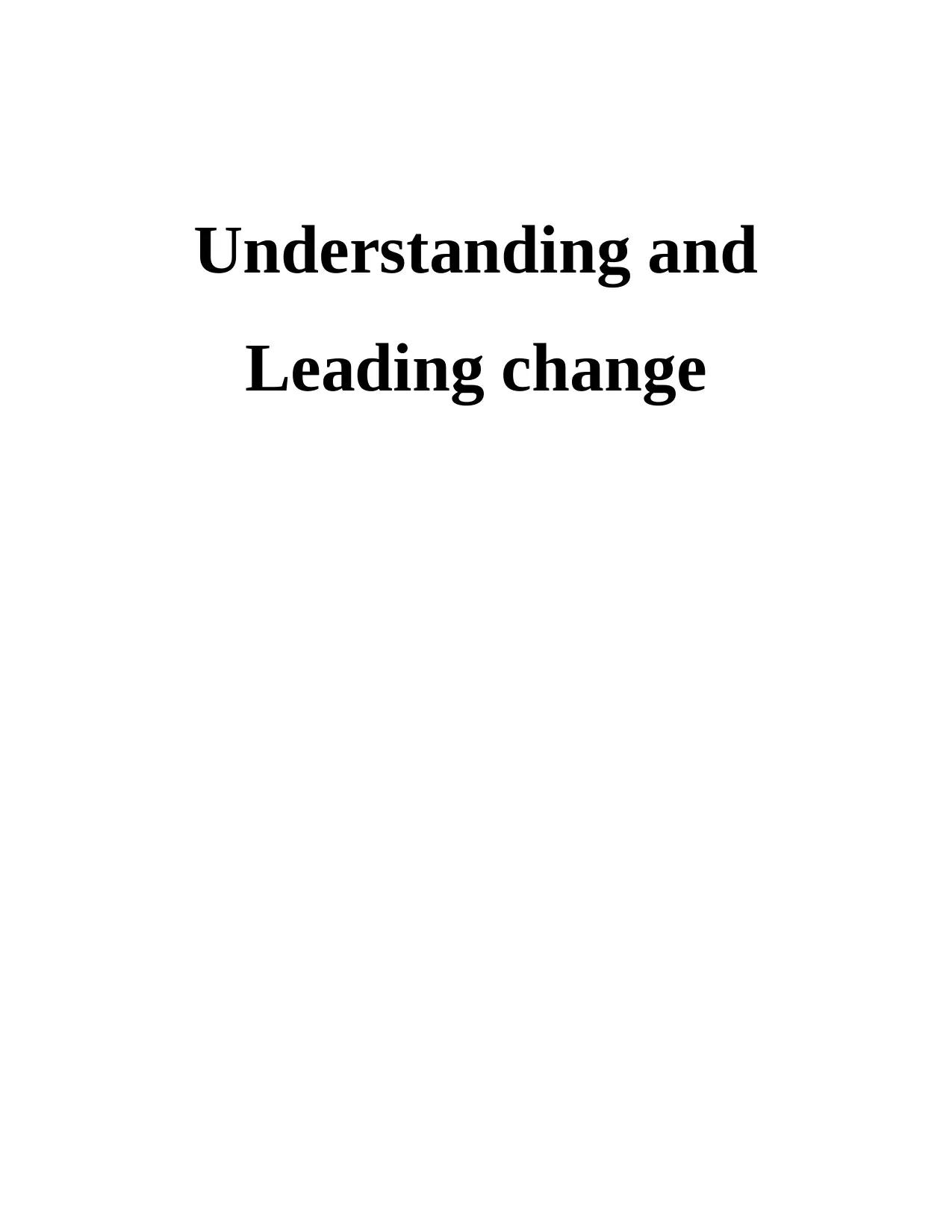
Understanding and
Leading change
Leading change
Secure Best Marks with AI Grader
Need help grading? Try our AI Grader for instant feedback on your assignments.
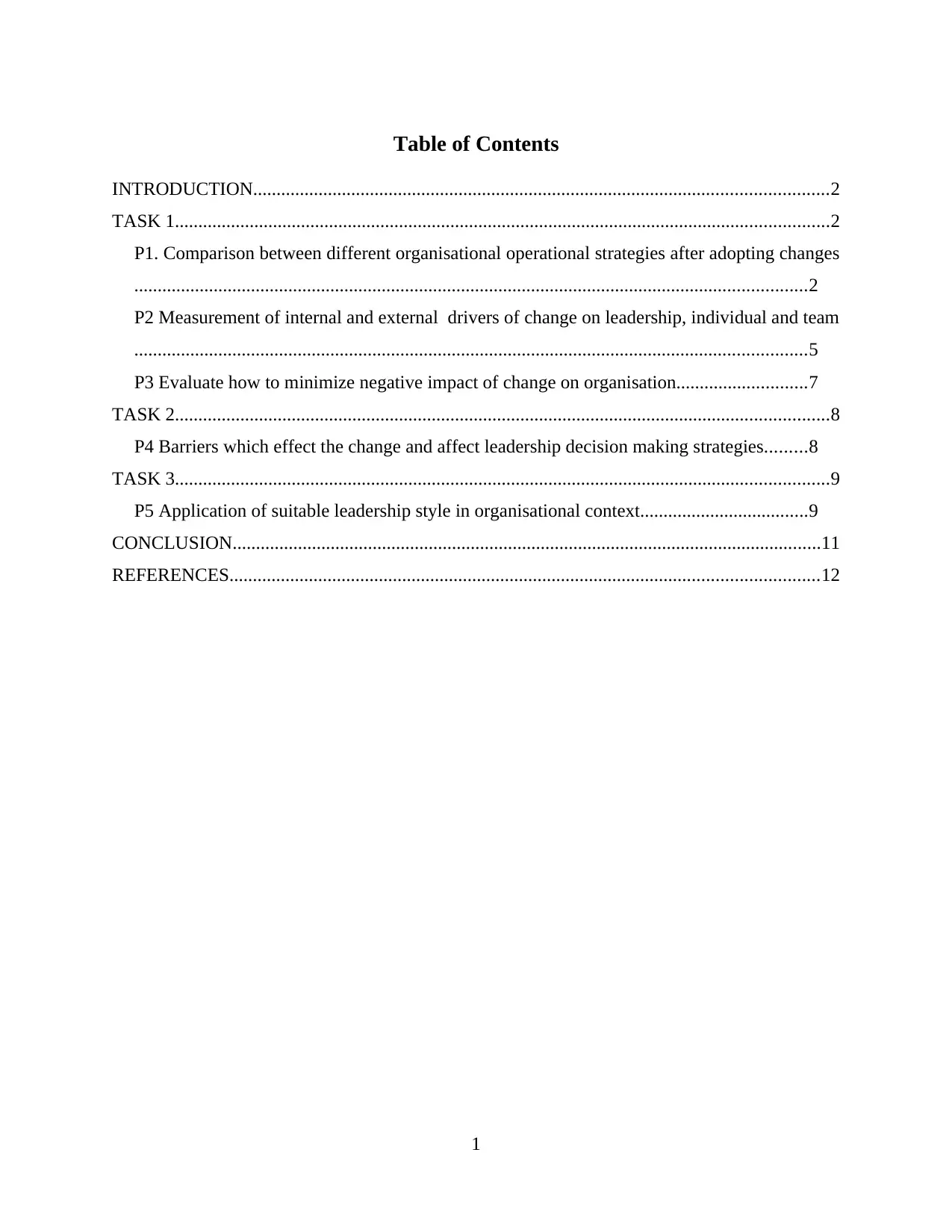
Table of Contents
INTRODUCTION...........................................................................................................................2
TASK 1............................................................................................................................................2
P1. Comparison between different organisational operational strategies after adopting changes
................................................................................................................................................2
P2 Measurement of internal and external drivers of change on leadership, individual and team
................................................................................................................................................5
P3 Evaluate how to minimize negative impact of change on organisation............................7
TASK 2............................................................................................................................................8
P4 Barriers which effect the change and affect leadership decision making strategies.........8
TASK 3............................................................................................................................................9
P5 Application of suitable leadership style in organisational context....................................9
CONCLUSION..............................................................................................................................11
REFERENCES..............................................................................................................................12
1
INTRODUCTION...........................................................................................................................2
TASK 1............................................................................................................................................2
P1. Comparison between different organisational operational strategies after adopting changes
................................................................................................................................................2
P2 Measurement of internal and external drivers of change on leadership, individual and team
................................................................................................................................................5
P3 Evaluate how to minimize negative impact of change on organisation............................7
TASK 2............................................................................................................................................8
P4 Barriers which effect the change and affect leadership decision making strategies.........8
TASK 3............................................................................................................................................9
P5 Application of suitable leadership style in organisational context....................................9
CONCLUSION..............................................................................................................................11
REFERENCES..............................................................................................................................12
1
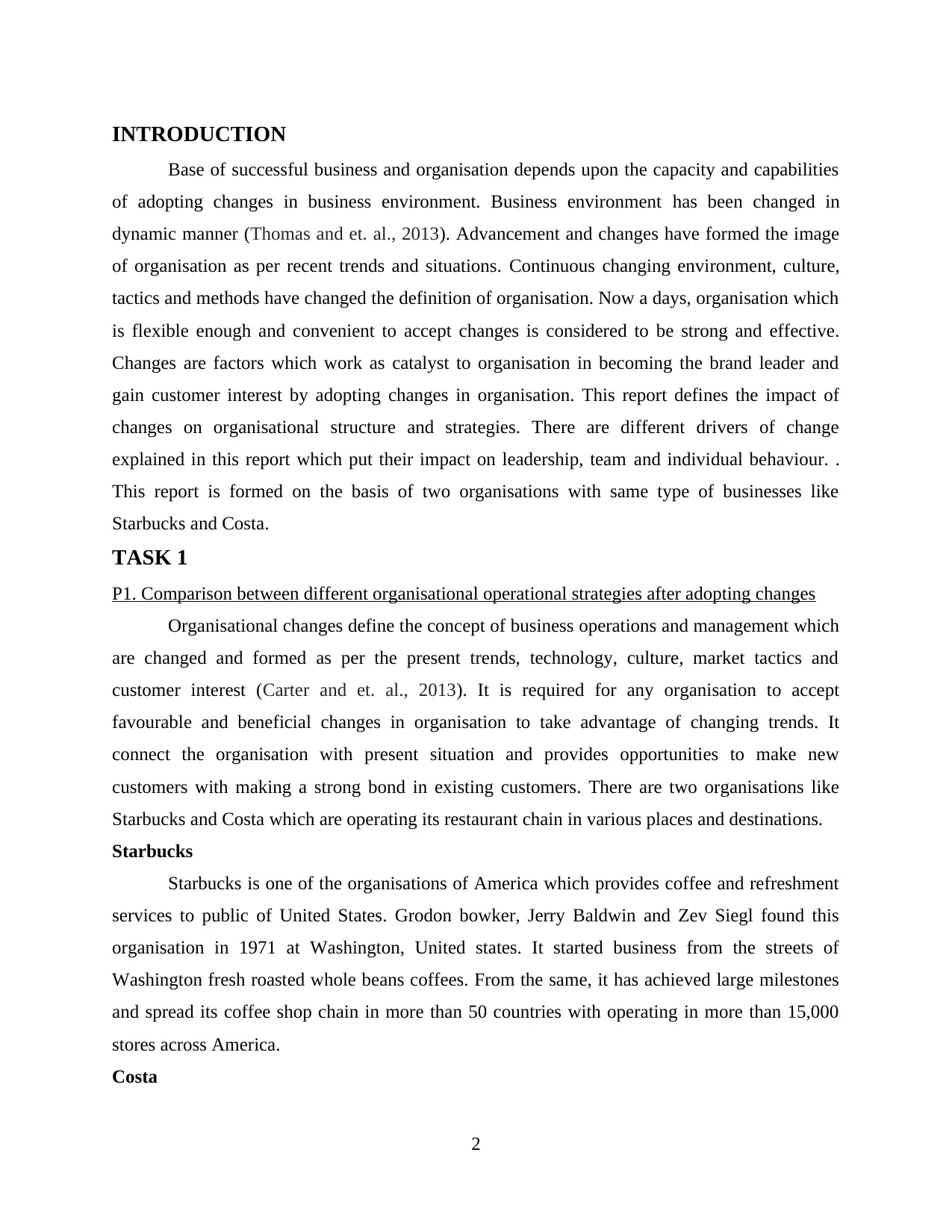
INTRODUCTION
Base of successful business and organisation depends upon the capacity and capabilities
of adopting changes in business environment. Business environment has been changed in
dynamic manner (Thomas and et. al., 2013). Advancement and changes have formed the image
of organisation as per recent trends and situations. Continuous changing environment, culture,
tactics and methods have changed the definition of organisation. Now a days, organisation which
is flexible enough and convenient to accept changes is considered to be strong and effective.
Changes are factors which work as catalyst to organisation in becoming the brand leader and
gain customer interest by adopting changes in organisation. This report defines the impact of
changes on organisational structure and strategies. There are different drivers of change
explained in this report which put their impact on leadership, team and individual behaviour. .
This report is formed on the basis of two organisations with same type of businesses like
Starbucks and Costa.
TASK 1
P1. Comparison between different organisational operational strategies after adopting changes
Organisational changes define the concept of business operations and management which
are changed and formed as per the present trends, technology, culture, market tactics and
customer interest (Carter and et. al., 2013). It is required for any organisation to accept
favourable and beneficial changes in organisation to take advantage of changing trends. It
connect the organisation with present situation and provides opportunities to make new
customers with making a strong bond in existing customers. There are two organisations like
Starbucks and Costa which are operating its restaurant chain in various places and destinations.
Starbucks
Starbucks is one of the organisations of America which provides coffee and refreshment
services to public of United States. Grodon bowker, Jerry Baldwin and Zev Siegl found this
organisation in 1971 at Washington, United states. It started business from the streets of
Washington fresh roasted whole beans coffees. From the same, it has achieved large milestones
and spread its coffee shop chain in more than 50 countries with operating in more than 15,000
stores across America.
Costa
2
Base of successful business and organisation depends upon the capacity and capabilities
of adopting changes in business environment. Business environment has been changed in
dynamic manner (Thomas and et. al., 2013). Advancement and changes have formed the image
of organisation as per recent trends and situations. Continuous changing environment, culture,
tactics and methods have changed the definition of organisation. Now a days, organisation which
is flexible enough and convenient to accept changes is considered to be strong and effective.
Changes are factors which work as catalyst to organisation in becoming the brand leader and
gain customer interest by adopting changes in organisation. This report defines the impact of
changes on organisational structure and strategies. There are different drivers of change
explained in this report which put their impact on leadership, team and individual behaviour. .
This report is formed on the basis of two organisations with same type of businesses like
Starbucks and Costa.
TASK 1
P1. Comparison between different organisational operational strategies after adopting changes
Organisational changes define the concept of business operations and management which
are changed and formed as per the present trends, technology, culture, market tactics and
customer interest (Carter and et. al., 2013). It is required for any organisation to accept
favourable and beneficial changes in organisation to take advantage of changing trends. It
connect the organisation with present situation and provides opportunities to make new
customers with making a strong bond in existing customers. There are two organisations like
Starbucks and Costa which are operating its restaurant chain in various places and destinations.
Starbucks
Starbucks is one of the organisations of America which provides coffee and refreshment
services to public of United States. Grodon bowker, Jerry Baldwin and Zev Siegl found this
organisation in 1971 at Washington, United states. It started business from the streets of
Washington fresh roasted whole beans coffees. From the same, it has achieved large milestones
and spread its coffee shop chain in more than 50 countries with operating in more than 15,000
stores across America.
Costa
2
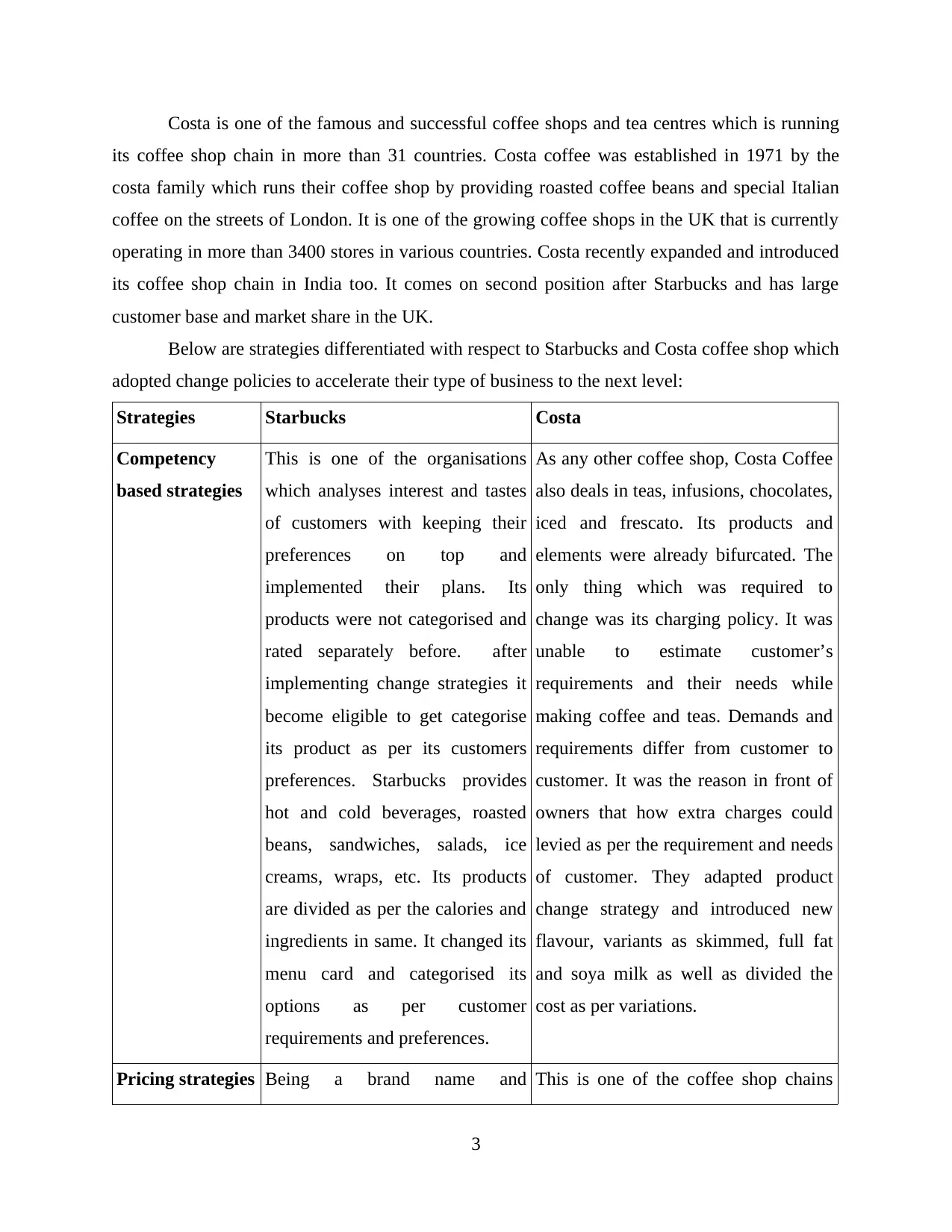
Costa is one of the famous and successful coffee shops and tea centres which is running
its coffee shop chain in more than 31 countries. Costa coffee was established in 1971 by the
costa family which runs their coffee shop by providing roasted coffee beans and special Italian
coffee on the streets of London. It is one of the growing coffee shops in the UK that is currently
operating in more than 3400 stores in various countries. Costa recently expanded and introduced
its coffee shop chain in India too. It comes on second position after Starbucks and has large
customer base and market share in the UK.
Below are strategies differentiated with respect to Starbucks and Costa coffee shop which
adopted change policies to accelerate their type of business to the next level:
Strategies Starbucks Costa
Competency
based strategies
This is one of the organisations
which analyses interest and tastes
of customers with keeping their
preferences on top and
implemented their plans. Its
products were not categorised and
rated separately before. after
implementing change strategies it
become eligible to get categorise
its product as per its customers
preferences. Starbucks provides
hot and cold beverages, roasted
beans, sandwiches, salads, ice
creams, wraps, etc. Its products
are divided as per the calories and
ingredients in same. It changed its
menu card and categorised its
options as per customer
requirements and preferences.
As any other coffee shop, Costa Coffee
also deals in teas, infusions, chocolates,
iced and frescato. Its products and
elements were already bifurcated. The
only thing which was required to
change was its charging policy. It was
unable to estimate customer’s
requirements and their needs while
making coffee and teas. Demands and
requirements differ from customer to
customer. It was the reason in front of
owners that how extra charges could
levied as per the requirement and needs
of customer. They adapted product
change strategy and introduced new
flavour, variants as skimmed, full fat
and soya milk as well as divided the
cost as per variations.
Pricing strategies Being a brand name and This is one of the coffee shop chains
3
its coffee shop chain in more than 31 countries. Costa coffee was established in 1971 by the
costa family which runs their coffee shop by providing roasted coffee beans and special Italian
coffee on the streets of London. It is one of the growing coffee shops in the UK that is currently
operating in more than 3400 stores in various countries. Costa recently expanded and introduced
its coffee shop chain in India too. It comes on second position after Starbucks and has large
customer base and market share in the UK.
Below are strategies differentiated with respect to Starbucks and Costa coffee shop which
adopted change policies to accelerate their type of business to the next level:
Strategies Starbucks Costa
Competency
based strategies
This is one of the organisations
which analyses interest and tastes
of customers with keeping their
preferences on top and
implemented their plans. Its
products were not categorised and
rated separately before. after
implementing change strategies it
become eligible to get categorise
its product as per its customers
preferences. Starbucks provides
hot and cold beverages, roasted
beans, sandwiches, salads, ice
creams, wraps, etc. Its products
are divided as per the calories and
ingredients in same. It changed its
menu card and categorised its
options as per customer
requirements and preferences.
As any other coffee shop, Costa Coffee
also deals in teas, infusions, chocolates,
iced and frescato. Its products and
elements were already bifurcated. The
only thing which was required to
change was its charging policy. It was
unable to estimate customer’s
requirements and their needs while
making coffee and teas. Demands and
requirements differ from customer to
customer. It was the reason in front of
owners that how extra charges could
levied as per the requirement and needs
of customer. They adapted product
change strategy and introduced new
flavour, variants as skimmed, full fat
and soya milk as well as divided the
cost as per variations.
Pricing strategies Being a brand name and This is one of the coffee shop chains
3
Secure Best Marks with AI Grader
Need help grading? Try our AI Grader for instant feedback on your assignments.
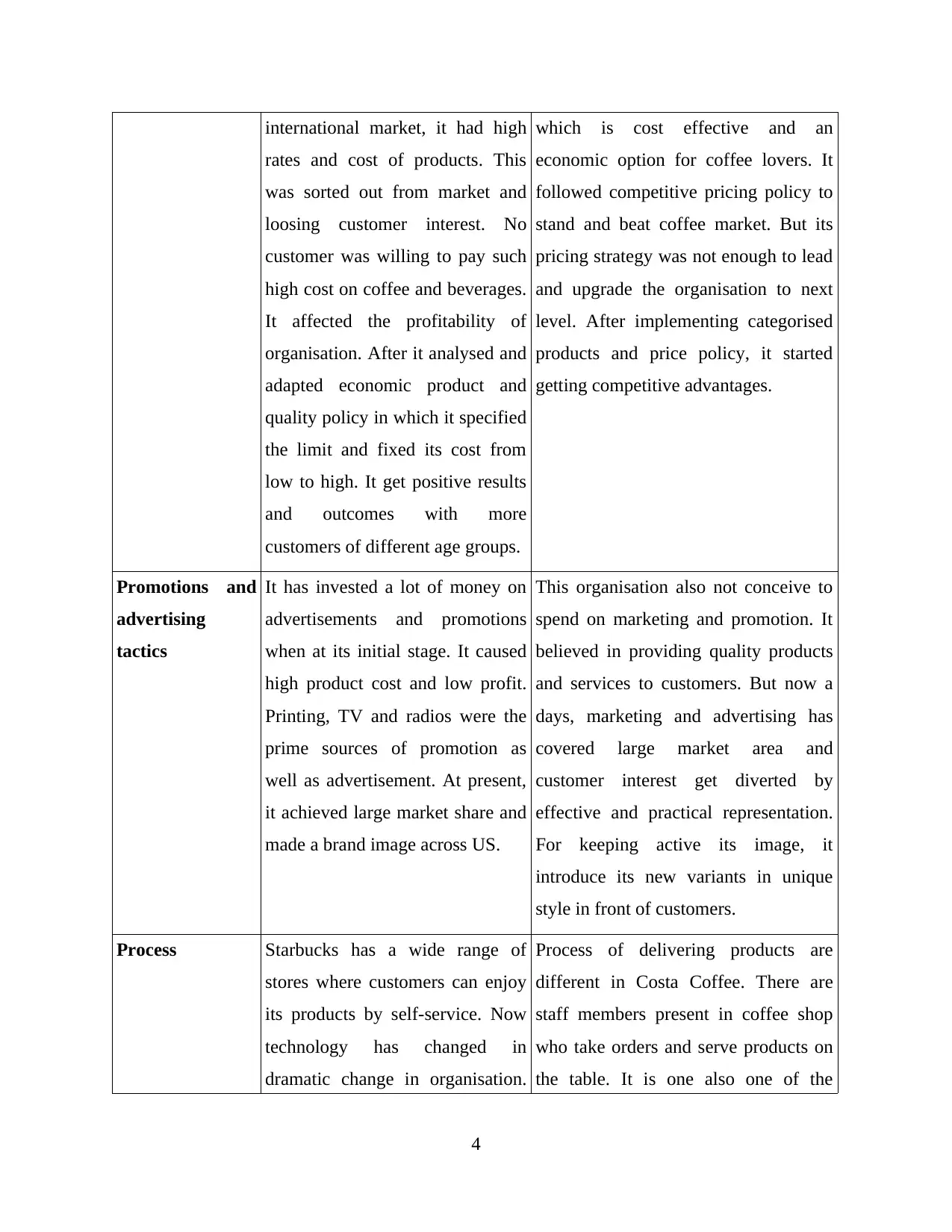
international market, it had high
rates and cost of products. This
was sorted out from market and
loosing customer interest. No
customer was willing to pay such
high cost on coffee and beverages.
It affected the profitability of
organisation. After it analysed and
adapted economic product and
quality policy in which it specified
the limit and fixed its cost from
low to high. It get positive results
and outcomes with more
customers of different age groups.
which is cost effective and an
economic option for coffee lovers. It
followed competitive pricing policy to
stand and beat coffee market. But its
pricing strategy was not enough to lead
and upgrade the organisation to next
level. After implementing categorised
products and price policy, it started
getting competitive advantages.
Promotions and
advertising
tactics
It has invested a lot of money on
advertisements and promotions
when at its initial stage. It caused
high product cost and low profit.
Printing, TV and radios were the
prime sources of promotion as
well as advertisement. At present,
it achieved large market share and
made a brand image across US.
This organisation also not conceive to
spend on marketing and promotion. It
believed in providing quality products
and services to customers. But now a
days, marketing and advertising has
covered large market area and
customer interest get diverted by
effective and practical representation.
For keeping active its image, it
introduce its new variants in unique
style in front of customers.
Process Starbucks has a wide range of
stores where customers can enjoy
its products by self-service. Now
technology has changed in
dramatic change in organisation.
Process of delivering products are
different in Costa Coffee. There are
staff members present in coffee shop
who take orders and serve products on
the table. It is one also one of the
4
rates and cost of products. This
was sorted out from market and
loosing customer interest. No
customer was willing to pay such
high cost on coffee and beverages.
It affected the profitability of
organisation. After it analysed and
adapted economic product and
quality policy in which it specified
the limit and fixed its cost from
low to high. It get positive results
and outcomes with more
customers of different age groups.
which is cost effective and an
economic option for coffee lovers. It
followed competitive pricing policy to
stand and beat coffee market. But its
pricing strategy was not enough to lead
and upgrade the organisation to next
level. After implementing categorised
products and price policy, it started
getting competitive advantages.
Promotions and
advertising
tactics
It has invested a lot of money on
advertisements and promotions
when at its initial stage. It caused
high product cost and low profit.
Printing, TV and radios were the
prime sources of promotion as
well as advertisement. At present,
it achieved large market share and
made a brand image across US.
This organisation also not conceive to
spend on marketing and promotion. It
believed in providing quality products
and services to customers. But now a
days, marketing and advertising has
covered large market area and
customer interest get diverted by
effective and practical representation.
For keeping active its image, it
introduce its new variants in unique
style in front of customers.
Process Starbucks has a wide range of
stores where customers can enjoy
its products by self-service. Now
technology has changed in
dramatic change in organisation.
Process of delivering products are
different in Costa Coffee. There are
staff members present in coffee shop
who take orders and serve products on
the table. It is one also one of the
4
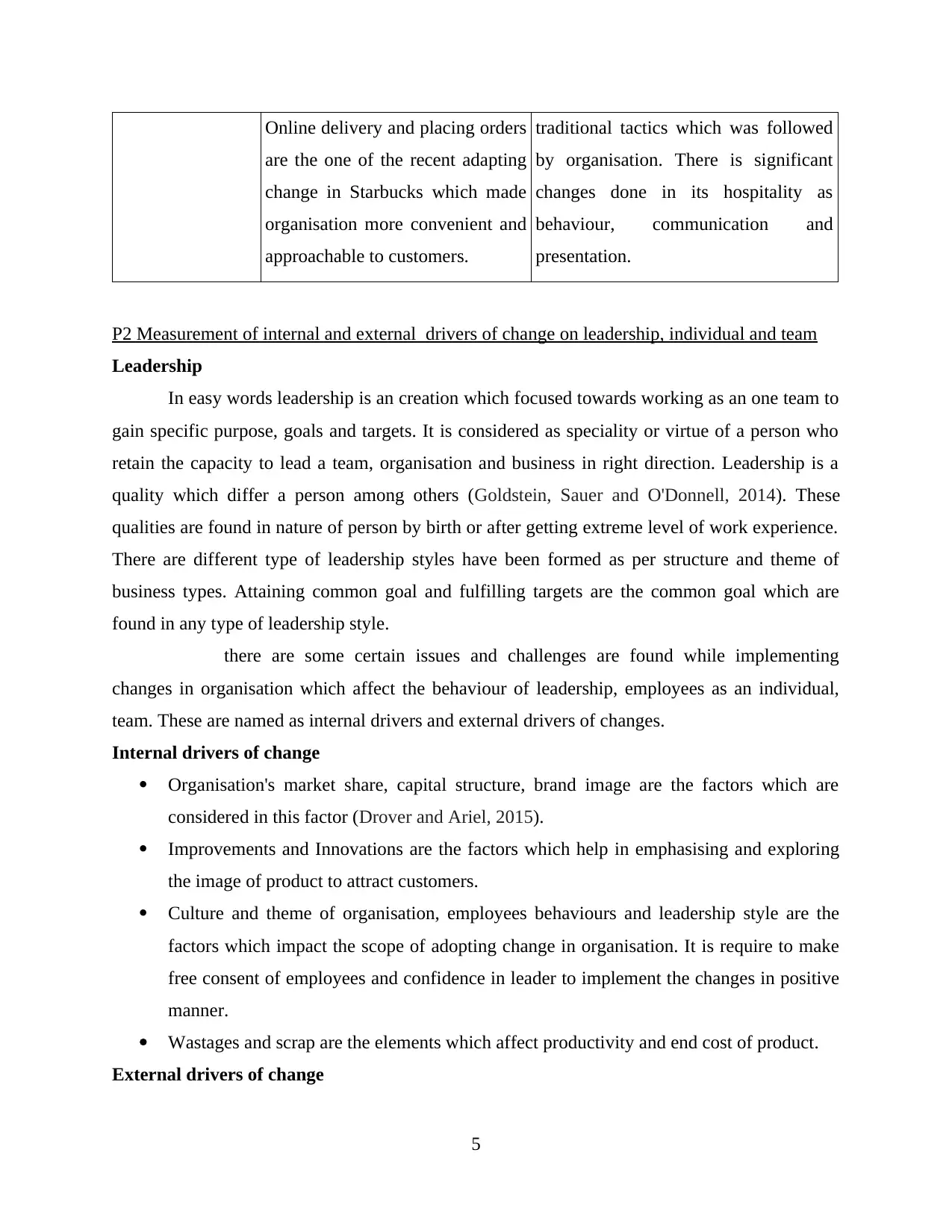
Online delivery and placing orders
are the one of the recent adapting
change in Starbucks which made
organisation more convenient and
approachable to customers.
traditional tactics which was followed
by organisation. There is significant
changes done in its hospitality as
behaviour, communication and
presentation.
P2 Measurement of internal and external drivers of change on leadership, individual and team
Leadership
In easy words leadership is an creation which focused towards working as an one team to
gain specific purpose, goals and targets. It is considered as speciality or virtue of a person who
retain the capacity to lead a team, organisation and business in right direction. Leadership is a
quality which differ a person among others (Goldstein, Sauer and O'Donnell, 2014). These
qualities are found in nature of person by birth or after getting extreme level of work experience.
There are different type of leadership styles have been formed as per structure and theme of
business types. Attaining common goal and fulfilling targets are the common goal which are
found in any type of leadership style.
there are some certain issues and challenges are found while implementing
changes in organisation which affect the behaviour of leadership, employees as an individual,
team. These are named as internal drivers and external drivers of changes.
Internal drivers of change
Organisation's market share, capital structure, brand image are the factors which are
considered in this factor (Drover and Ariel, 2015).
Improvements and Innovations are the factors which help in emphasising and exploring
the image of product to attract customers.
Culture and theme of organisation, employees behaviours and leadership style are the
factors which impact the scope of adopting change in organisation. It is require to make
free consent of employees and confidence in leader to implement the changes in positive
manner.
Wastages and scrap are the elements which affect productivity and end cost of product.
External drivers of change
5
are the one of the recent adapting
change in Starbucks which made
organisation more convenient and
approachable to customers.
traditional tactics which was followed
by organisation. There is significant
changes done in its hospitality as
behaviour, communication and
presentation.
P2 Measurement of internal and external drivers of change on leadership, individual and team
Leadership
In easy words leadership is an creation which focused towards working as an one team to
gain specific purpose, goals and targets. It is considered as speciality or virtue of a person who
retain the capacity to lead a team, organisation and business in right direction. Leadership is a
quality which differ a person among others (Goldstein, Sauer and O'Donnell, 2014). These
qualities are found in nature of person by birth or after getting extreme level of work experience.
There are different type of leadership styles have been formed as per structure and theme of
business types. Attaining common goal and fulfilling targets are the common goal which are
found in any type of leadership style.
there are some certain issues and challenges are found while implementing
changes in organisation which affect the behaviour of leadership, employees as an individual,
team. These are named as internal drivers and external drivers of changes.
Internal drivers of change
Organisation's market share, capital structure, brand image are the factors which are
considered in this factor (Drover and Ariel, 2015).
Improvements and Innovations are the factors which help in emphasising and exploring
the image of product to attract customers.
Culture and theme of organisation, employees behaviours and leadership style are the
factors which impact the scope of adopting change in organisation. It is require to make
free consent of employees and confidence in leader to implement the changes in positive
manner.
Wastages and scrap are the elements which affect productivity and end cost of product.
External drivers of change
5
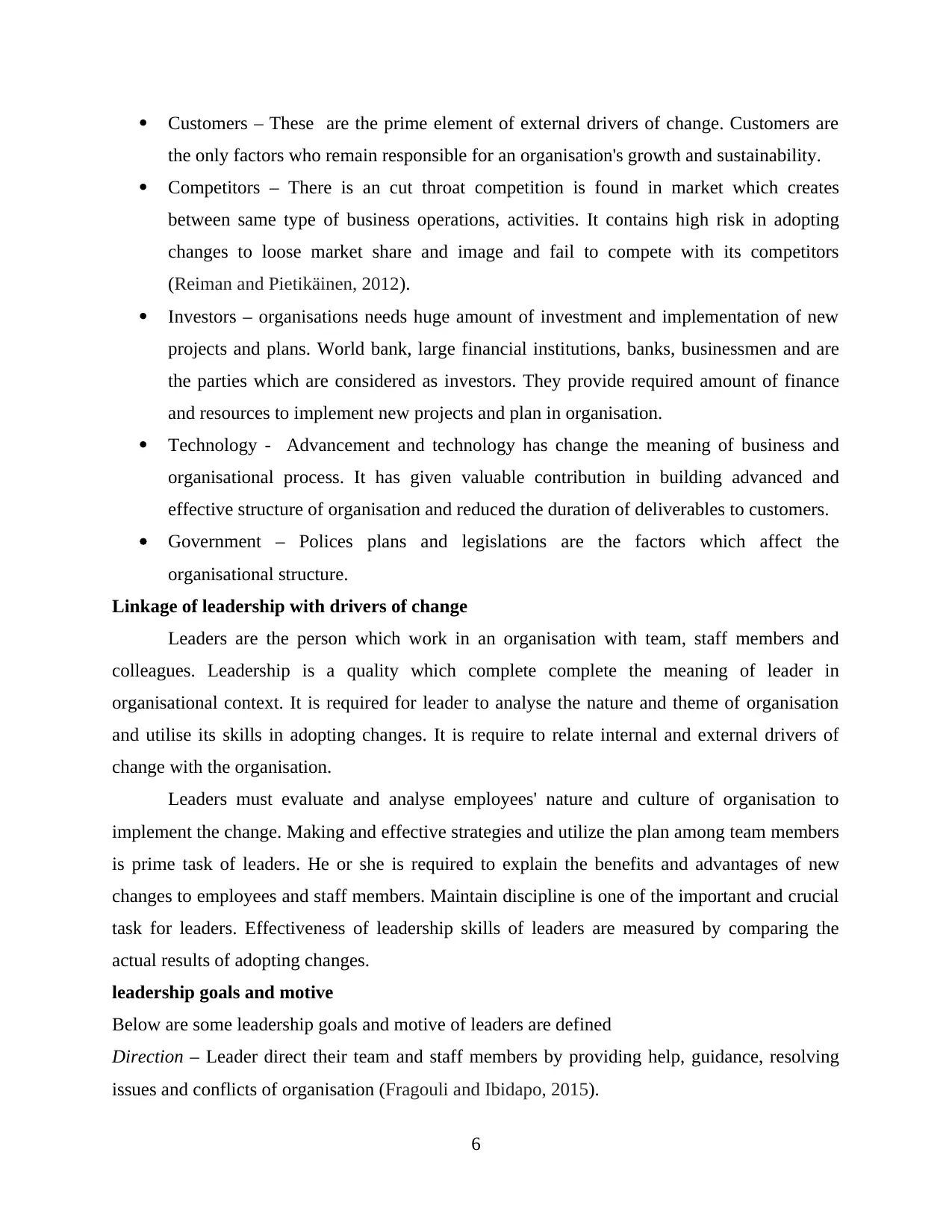
Customers – These are the prime element of external drivers of change. Customers are
the only factors who remain responsible for an organisation's growth and sustainability.
Competitors – There is an cut throat competition is found in market which creates
between same type of business operations, activities. It contains high risk in adopting
changes to loose market share and image and fail to compete with its competitors
(Reiman and Pietikäinen, 2012).
Investors – organisations needs huge amount of investment and implementation of new
projects and plans. World bank, large financial institutions, banks, businessmen and are
the parties which are considered as investors. They provide required amount of finance
and resources to implement new projects and plan in organisation.
Technology - Advancement and technology has change the meaning of business and
organisational process. It has given valuable contribution in building advanced and
effective structure of organisation and reduced the duration of deliverables to customers.
Government – Polices plans and legislations are the factors which affect the
organisational structure.
Linkage of leadership with drivers of change
Leaders are the person which work in an organisation with team, staff members and
colleagues. Leadership is a quality which complete complete the meaning of leader in
organisational context. It is required for leader to analyse the nature and theme of organisation
and utilise its skills in adopting changes. It is require to relate internal and external drivers of
change with the organisation.
Leaders must evaluate and analyse employees' nature and culture of organisation to
implement the change. Making and effective strategies and utilize the plan among team members
is prime task of leaders. He or she is required to explain the benefits and advantages of new
changes to employees and staff members. Maintain discipline is one of the important and crucial
task for leaders. Effectiveness of leadership skills of leaders are measured by comparing the
actual results of adopting changes.
leadership goals and motive
Below are some leadership goals and motive of leaders are defined
Direction – Leader direct their team and staff members by providing help, guidance, resolving
issues and conflicts of organisation (Fragouli and Ibidapo, 2015).
6
the only factors who remain responsible for an organisation's growth and sustainability.
Competitors – There is an cut throat competition is found in market which creates
between same type of business operations, activities. It contains high risk in adopting
changes to loose market share and image and fail to compete with its competitors
(Reiman and Pietikäinen, 2012).
Investors – organisations needs huge amount of investment and implementation of new
projects and plans. World bank, large financial institutions, banks, businessmen and are
the parties which are considered as investors. They provide required amount of finance
and resources to implement new projects and plan in organisation.
Technology - Advancement and technology has change the meaning of business and
organisational process. It has given valuable contribution in building advanced and
effective structure of organisation and reduced the duration of deliverables to customers.
Government – Polices plans and legislations are the factors which affect the
organisational structure.
Linkage of leadership with drivers of change
Leaders are the person which work in an organisation with team, staff members and
colleagues. Leadership is a quality which complete complete the meaning of leader in
organisational context. It is required for leader to analyse the nature and theme of organisation
and utilise its skills in adopting changes. It is require to relate internal and external drivers of
change with the organisation.
Leaders must evaluate and analyse employees' nature and culture of organisation to
implement the change. Making and effective strategies and utilize the plan among team members
is prime task of leaders. He or she is required to explain the benefits and advantages of new
changes to employees and staff members. Maintain discipline is one of the important and crucial
task for leaders. Effectiveness of leadership skills of leaders are measured by comparing the
actual results of adopting changes.
leadership goals and motive
Below are some leadership goals and motive of leaders are defined
Direction – Leader direct their team and staff members by providing help, guidance, resolving
issues and conflicts of organisation (Fragouli and Ibidapo, 2015).
6
Paraphrase This Document
Need a fresh take? Get an instant paraphrase of this document with our AI Paraphraser
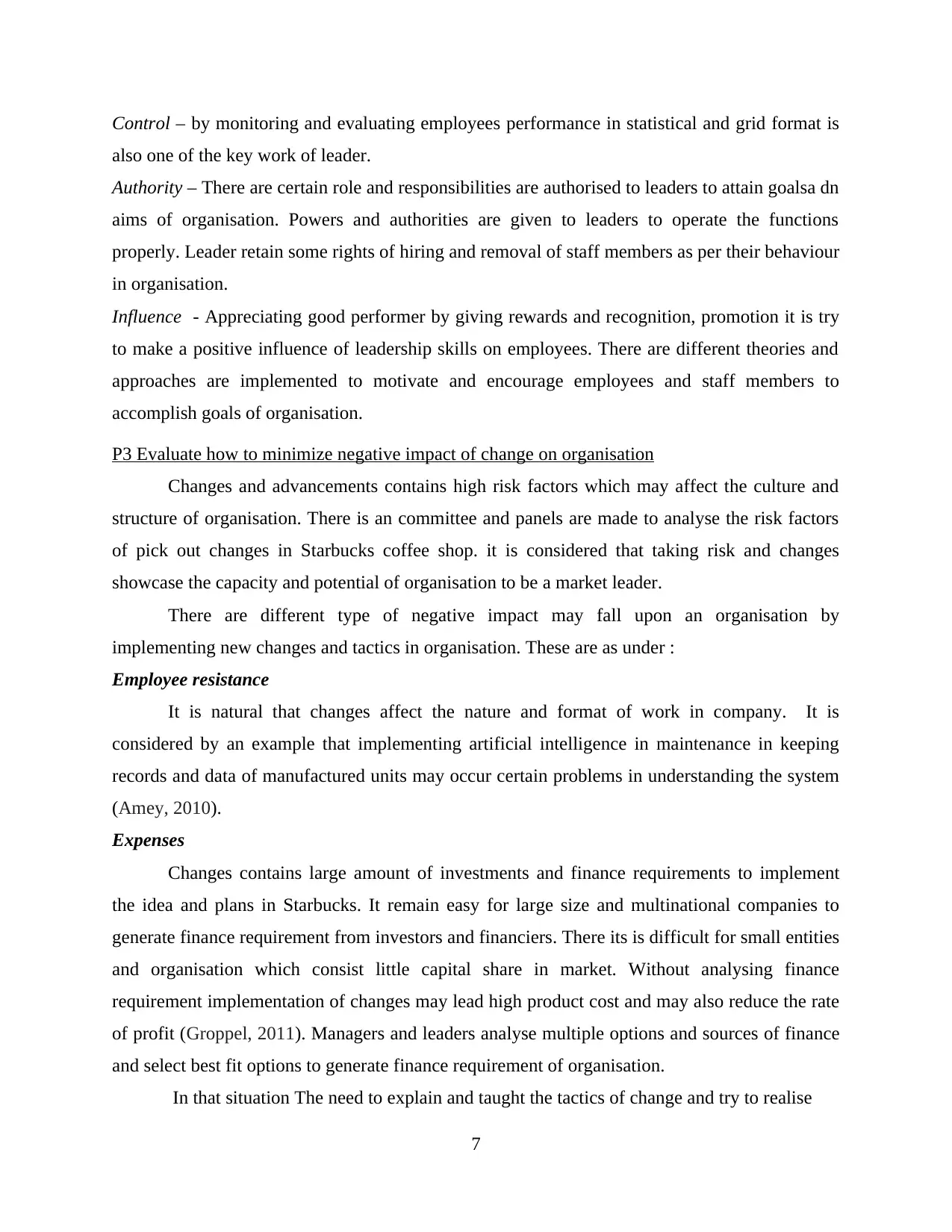
Control – by monitoring and evaluating employees performance in statistical and grid format is
also one of the key work of leader.
Authority – There are certain role and responsibilities are authorised to leaders to attain goalsa dn
aims of organisation. Powers and authorities are given to leaders to operate the functions
properly. Leader retain some rights of hiring and removal of staff members as per their behaviour
in organisation.
Influence - Appreciating good performer by giving rewards and recognition, promotion it is try
to make a positive influence of leadership skills on employees. There are different theories and
approaches are implemented to motivate and encourage employees and staff members to
accomplish goals of organisation.
P3 Evaluate how to minimize negative impact of change on organisation
Changes and advancements contains high risk factors which may affect the culture and
structure of organisation. There is an committee and panels are made to analyse the risk factors
of pick out changes in Starbucks coffee shop. it is considered that taking risk and changes
showcase the capacity and potential of organisation to be a market leader.
There are different type of negative impact may fall upon an organisation by
implementing new changes and tactics in organisation. These are as under :
Employee resistance
It is natural that changes affect the nature and format of work in company. It is
considered by an example that implementing artificial intelligence in maintenance in keeping
records and data of manufactured units may occur certain problems in understanding the system
(Amey, 2010).
Expenses
Changes contains large amount of investments and finance requirements to implement
the idea and plans in Starbucks. It remain easy for large size and multinational companies to
generate finance requirement from investors and financiers. There its is difficult for small entities
and organisation which consist little capital share in market. Without analysing finance
requirement implementation of changes may lead high product cost and may also reduce the rate
of profit (Groppel, 2011). Managers and leaders analyse multiple options and sources of finance
and select best fit options to generate finance requirement of organisation.
In that situation The need to explain and taught the tactics of change and try to realise
7
also one of the key work of leader.
Authority – There are certain role and responsibilities are authorised to leaders to attain goalsa dn
aims of organisation. Powers and authorities are given to leaders to operate the functions
properly. Leader retain some rights of hiring and removal of staff members as per their behaviour
in organisation.
Influence - Appreciating good performer by giving rewards and recognition, promotion it is try
to make a positive influence of leadership skills on employees. There are different theories and
approaches are implemented to motivate and encourage employees and staff members to
accomplish goals of organisation.
P3 Evaluate how to minimize negative impact of change on organisation
Changes and advancements contains high risk factors which may affect the culture and
structure of organisation. There is an committee and panels are made to analyse the risk factors
of pick out changes in Starbucks coffee shop. it is considered that taking risk and changes
showcase the capacity and potential of organisation to be a market leader.
There are different type of negative impact may fall upon an organisation by
implementing new changes and tactics in organisation. These are as under :
Employee resistance
It is natural that changes affect the nature and format of work in company. It is
considered by an example that implementing artificial intelligence in maintenance in keeping
records and data of manufactured units may occur certain problems in understanding the system
(Amey, 2010).
Expenses
Changes contains large amount of investments and finance requirements to implement
the idea and plans in Starbucks. It remain easy for large size and multinational companies to
generate finance requirement from investors and financiers. There its is difficult for small entities
and organisation which consist little capital share in market. Without analysing finance
requirement implementation of changes may lead high product cost and may also reduce the rate
of profit (Groppel, 2011). Managers and leaders analyse multiple options and sources of finance
and select best fit options to generate finance requirement of organisation.
In that situation The need to explain and taught the tactics of change and try to realise
7
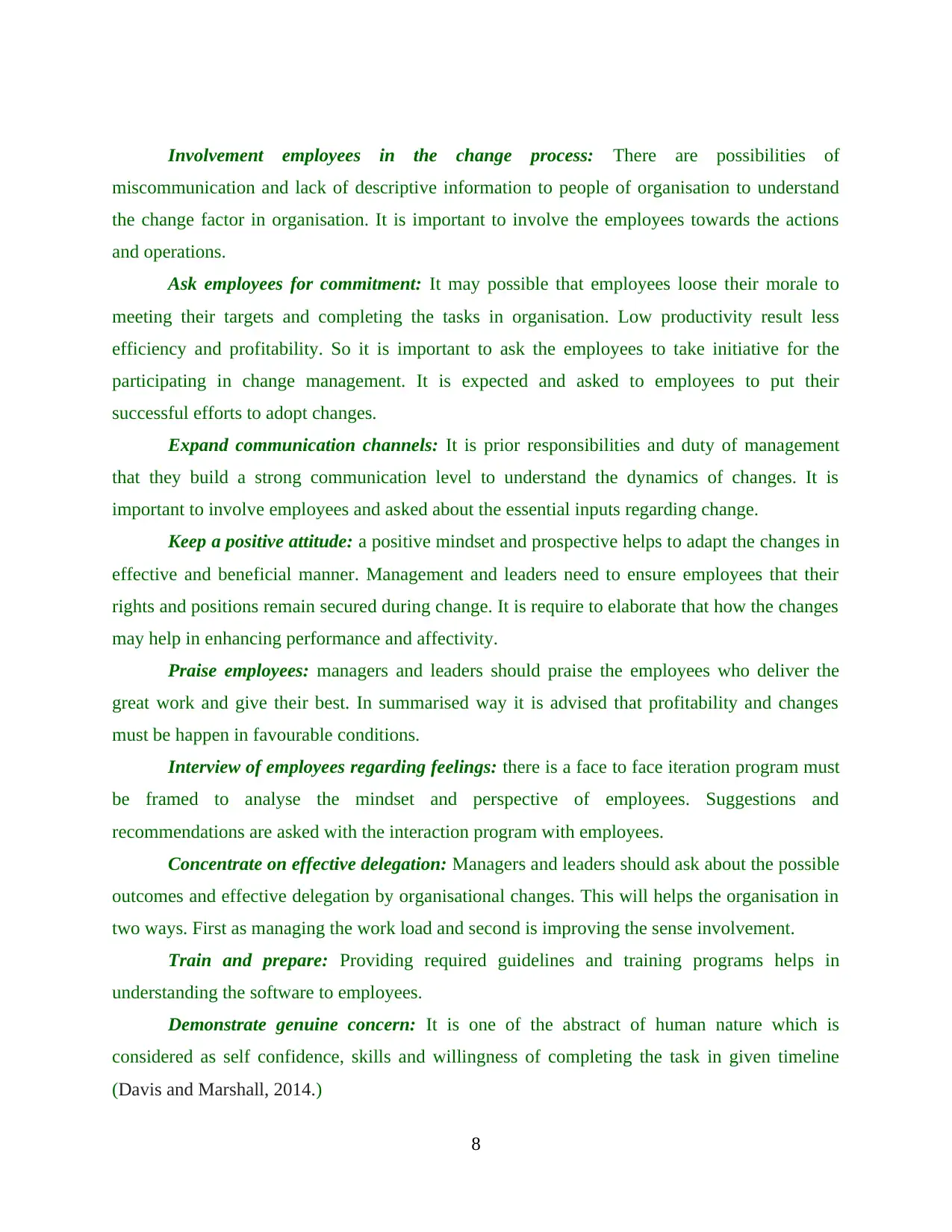
Involvement employees in the change process: There are possibilities of
miscommunication and lack of descriptive information to people of organisation to understand
the change factor in organisation. It is important to involve the employees towards the actions
and operations.
Ask employees for commitment: It may possible that employees loose their morale to
meeting their targets and completing the tasks in organisation. Low productivity result less
efficiency and profitability. So it is important to ask the employees to take initiative for the
participating in change management. It is expected and asked to employees to put their
successful efforts to adopt changes.
Expand communication channels: It is prior responsibilities and duty of management
that they build a strong communication level to understand the dynamics of changes. It is
important to involve employees and asked about the essential inputs regarding change.
Keep a positive attitude: a positive mindset and prospective helps to adapt the changes in
effective and beneficial manner. Management and leaders need to ensure employees that their
rights and positions remain secured during change. It is require to elaborate that how the changes
may help in enhancing performance and affectivity.
Praise employees: managers and leaders should praise the employees who deliver the
great work and give their best. In summarised way it is advised that profitability and changes
must be happen in favourable conditions.
Interview of employees regarding feelings: there is a face to face iteration program must
be framed to analyse the mindset and perspective of employees. Suggestions and
recommendations are asked with the interaction program with employees.
Concentrate on effective delegation: Managers and leaders should ask about the possible
outcomes and effective delegation by organisational changes. This will helps the organisation in
two ways. First as managing the work load and second is improving the sense involvement.
Train and prepare: Providing required guidelines and training programs helps in
understanding the software to employees.
Demonstrate genuine concern: It is one of the abstract of human nature which is
considered as self confidence, skills and willingness of completing the task in given timeline
(Davis and Marshall, 2014.)
8
miscommunication and lack of descriptive information to people of organisation to understand
the change factor in organisation. It is important to involve the employees towards the actions
and operations.
Ask employees for commitment: It may possible that employees loose their morale to
meeting their targets and completing the tasks in organisation. Low productivity result less
efficiency and profitability. So it is important to ask the employees to take initiative for the
participating in change management. It is expected and asked to employees to put their
successful efforts to adopt changes.
Expand communication channels: It is prior responsibilities and duty of management
that they build a strong communication level to understand the dynamics of changes. It is
important to involve employees and asked about the essential inputs regarding change.
Keep a positive attitude: a positive mindset and prospective helps to adapt the changes in
effective and beneficial manner. Management and leaders need to ensure employees that their
rights and positions remain secured during change. It is require to elaborate that how the changes
may help in enhancing performance and affectivity.
Praise employees: managers and leaders should praise the employees who deliver the
great work and give their best. In summarised way it is advised that profitability and changes
must be happen in favourable conditions.
Interview of employees regarding feelings: there is a face to face iteration program must
be framed to analyse the mindset and perspective of employees. Suggestions and
recommendations are asked with the interaction program with employees.
Concentrate on effective delegation: Managers and leaders should ask about the possible
outcomes and effective delegation by organisational changes. This will helps the organisation in
two ways. First as managing the work load and second is improving the sense involvement.
Train and prepare: Providing required guidelines and training programs helps in
understanding the software to employees.
Demonstrate genuine concern: It is one of the abstract of human nature which is
considered as self confidence, skills and willingness of completing the task in given timeline
(Davis and Marshall, 2014.)
8
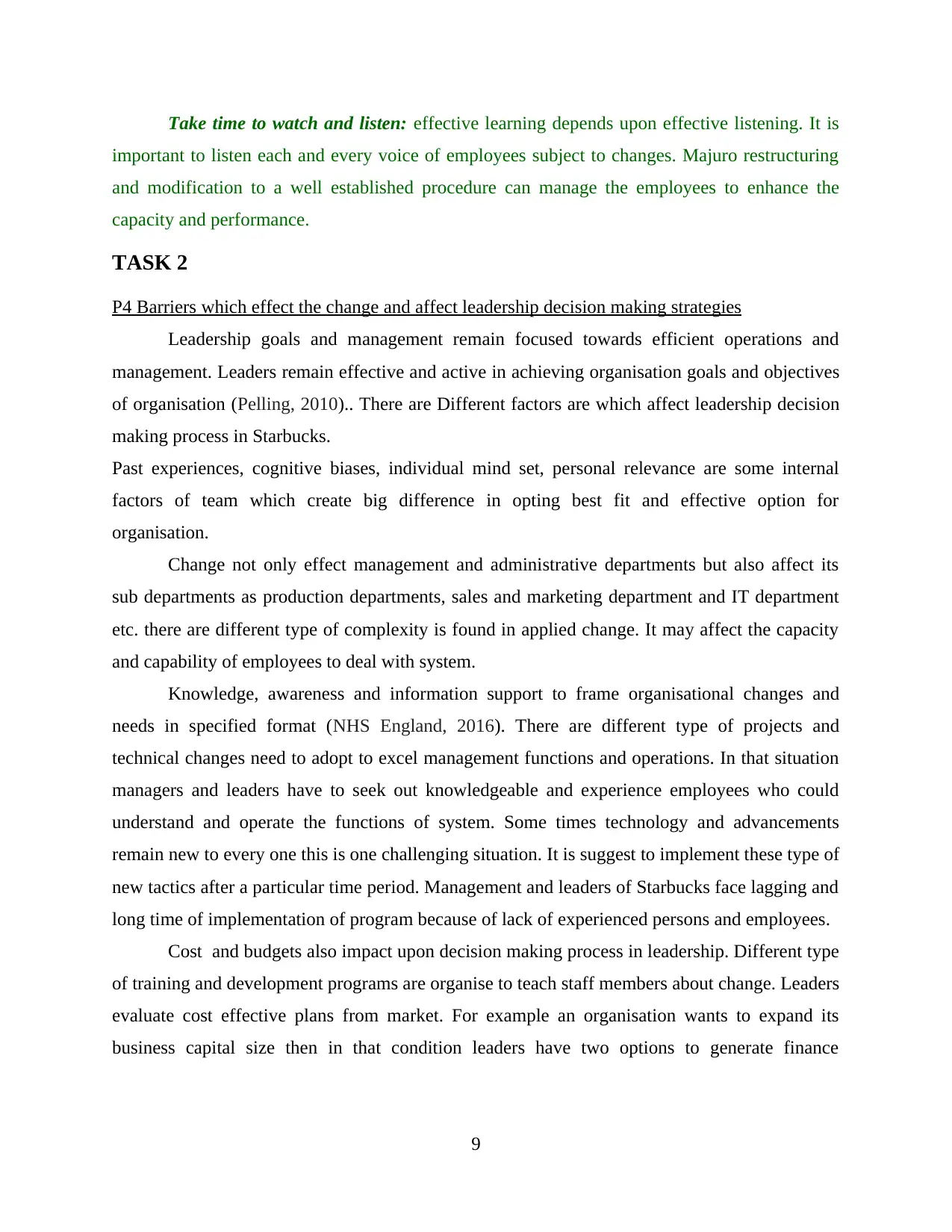
Take time to watch and listen: effective learning depends upon effective listening. It is
important to listen each and every voice of employees subject to changes. Majuro restructuring
and modification to a well established procedure can manage the employees to enhance the
capacity and performance.
TASK 2
P4 Barriers which effect the change and affect leadership decision making strategies
Leadership goals and management remain focused towards efficient operations and
management. Leaders remain effective and active in achieving organisation goals and objectives
of organisation (Pelling, 2010).. There are Different factors are which affect leadership decision
making process in Starbucks.
Past experiences, cognitive biases, individual mind set, personal relevance are some internal
factors of team which create big difference in opting best fit and effective option for
organisation.
Change not only effect management and administrative departments but also affect its
sub departments as production departments, sales and marketing department and IT department
etc. there are different type of complexity is found in applied change. It may affect the capacity
and capability of employees to deal with system.
Knowledge, awareness and information support to frame organisational changes and
needs in specified format (NHS England, 2016). There are different type of projects and
technical changes need to adopt to excel management functions and operations. In that situation
managers and leaders have to seek out knowledgeable and experience employees who could
understand and operate the functions of system. Some times technology and advancements
remain new to every one this is one challenging situation. It is suggest to implement these type of
new tactics after a particular time period. Management and leaders of Starbucks face lagging and
long time of implementation of program because of lack of experienced persons and employees.
Cost and budgets also impact upon decision making process in leadership. Different type
of training and development programs are organise to teach staff members about change. Leaders
evaluate cost effective plans from market. For example an organisation wants to expand its
business capital size then in that condition leaders have two options to generate finance
9
important to listen each and every voice of employees subject to changes. Majuro restructuring
and modification to a well established procedure can manage the employees to enhance the
capacity and performance.
TASK 2
P4 Barriers which effect the change and affect leadership decision making strategies
Leadership goals and management remain focused towards efficient operations and
management. Leaders remain effective and active in achieving organisation goals and objectives
of organisation (Pelling, 2010).. There are Different factors are which affect leadership decision
making process in Starbucks.
Past experiences, cognitive biases, individual mind set, personal relevance are some internal
factors of team which create big difference in opting best fit and effective option for
organisation.
Change not only effect management and administrative departments but also affect its
sub departments as production departments, sales and marketing department and IT department
etc. there are different type of complexity is found in applied change. It may affect the capacity
and capability of employees to deal with system.
Knowledge, awareness and information support to frame organisational changes and
needs in specified format (NHS England, 2016). There are different type of projects and
technical changes need to adopt to excel management functions and operations. In that situation
managers and leaders have to seek out knowledgeable and experience employees who could
understand and operate the functions of system. Some times technology and advancements
remain new to every one this is one challenging situation. It is suggest to implement these type of
new tactics after a particular time period. Management and leaders of Starbucks face lagging and
long time of implementation of program because of lack of experienced persons and employees.
Cost and budgets also impact upon decision making process in leadership. Different type
of training and development programs are organise to teach staff members about change. Leaders
evaluate cost effective plans from market. For example an organisation wants to expand its
business capital size then in that condition leaders have two options to generate finance
9
Secure Best Marks with AI Grader
Need help grading? Try our AI Grader for instant feedback on your assignments.
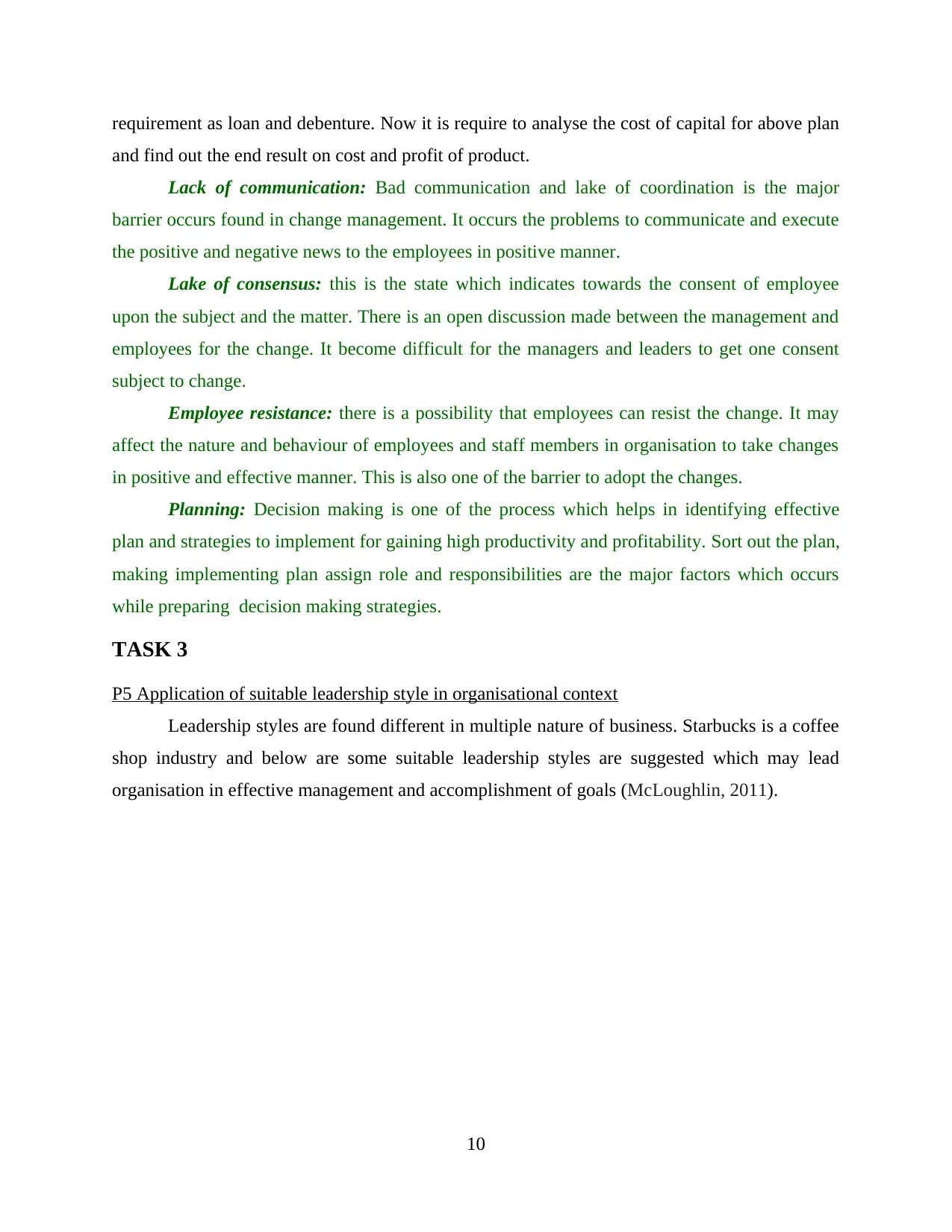
requirement as loan and debenture. Now it is require to analyse the cost of capital for above plan
and find out the end result on cost and profit of product.
Lack of communication: Bad communication and lake of coordination is the major
barrier occurs found in change management. It occurs the problems to communicate and execute
the positive and negative news to the employees in positive manner.
Lake of consensus: this is the state which indicates towards the consent of employee
upon the subject and the matter. There is an open discussion made between the management and
employees for the change. It become difficult for the managers and leaders to get one consent
subject to change.
Employee resistance: there is a possibility that employees can resist the change. It may
affect the nature and behaviour of employees and staff members in organisation to take changes
in positive and effective manner. This is also one of the barrier to adopt the changes.
Planning: Decision making is one of the process which helps in identifying effective
plan and strategies to implement for gaining high productivity and profitability. Sort out the plan,
making implementing plan assign role and responsibilities are the major factors which occurs
while preparing decision making strategies.
TASK 3
P5 Application of suitable leadership style in organisational context
Leadership styles are found different in multiple nature of business. Starbucks is a coffee
shop industry and below are some suitable leadership styles are suggested which may lead
organisation in effective management and accomplishment of goals (McLoughlin, 2011).
10
and find out the end result on cost and profit of product.
Lack of communication: Bad communication and lake of coordination is the major
barrier occurs found in change management. It occurs the problems to communicate and execute
the positive and negative news to the employees in positive manner.
Lake of consensus: this is the state which indicates towards the consent of employee
upon the subject and the matter. There is an open discussion made between the management and
employees for the change. It become difficult for the managers and leaders to get one consent
subject to change.
Employee resistance: there is a possibility that employees can resist the change. It may
affect the nature and behaviour of employees and staff members in organisation to take changes
in positive and effective manner. This is also one of the barrier to adopt the changes.
Planning: Decision making is one of the process which helps in identifying effective
plan and strategies to implement for gaining high productivity and profitability. Sort out the plan,
making implementing plan assign role and responsibilities are the major factors which occurs
while preparing decision making strategies.
TASK 3
P5 Application of suitable leadership style in organisational context
Leadership styles are found different in multiple nature of business. Starbucks is a coffee
shop industry and below are some suitable leadership styles are suggested which may lead
organisation in effective management and accomplishment of goals (McLoughlin, 2011).
10
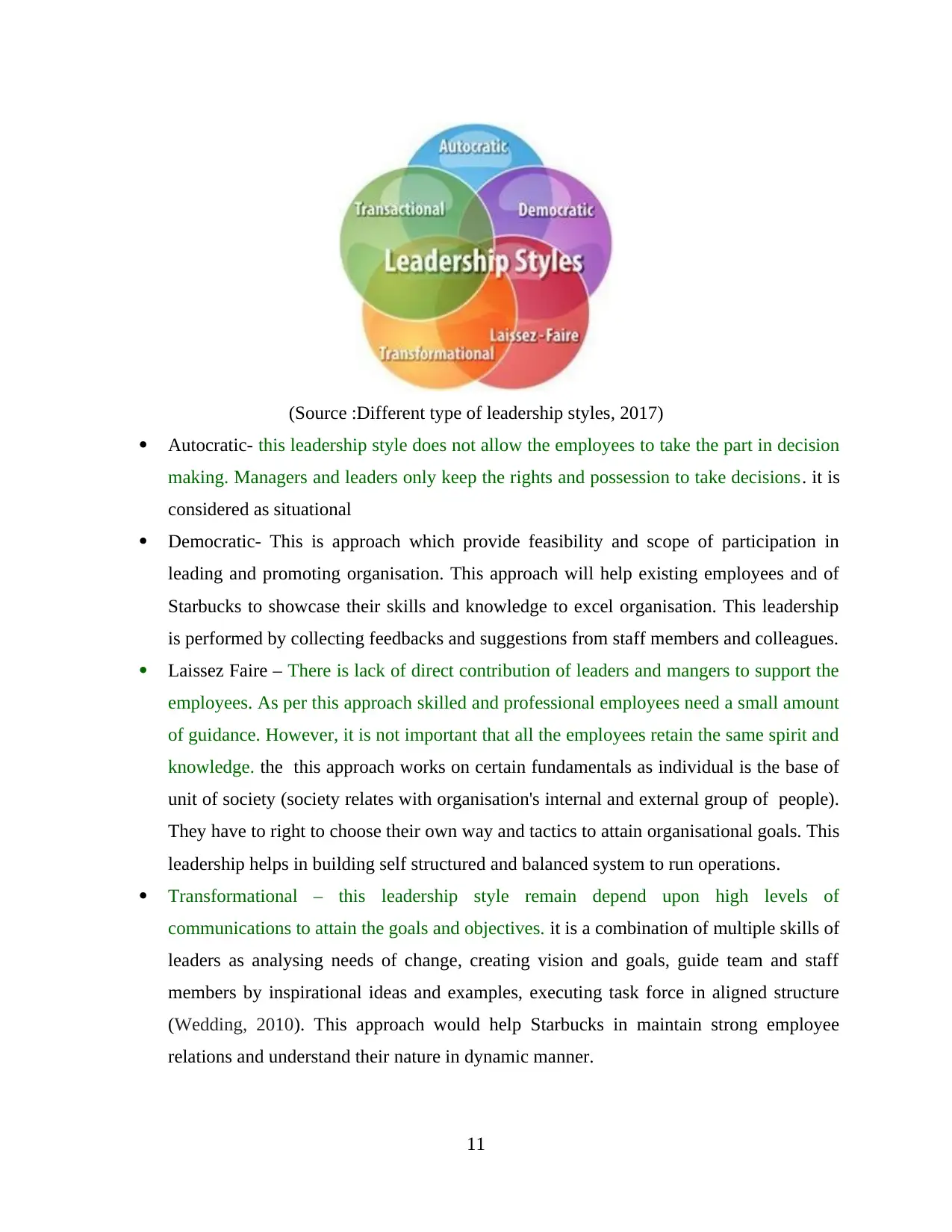
(Source :Different type of leadership styles, 2017)
Autocratic- this leadership style does not allow the employees to take the part in decision
making. Managers and leaders only keep the rights and possession to take decisions. it is
considered as situational
Democratic- This is approach which provide feasibility and scope of participation in
leading and promoting organisation. This approach will help existing employees and of
Starbucks to showcase their skills and knowledge to excel organisation. This leadership
is performed by collecting feedbacks and suggestions from staff members and colleagues.
Laissez Faire – There is lack of direct contribution of leaders and mangers to support the
employees. As per this approach skilled and professional employees need a small amount
of guidance. However, it is not important that all the employees retain the same spirit and
knowledge. the this approach works on certain fundamentals as individual is the base of
unit of society (society relates with organisation's internal and external group of people).
They have to right to choose their own way and tactics to attain organisational goals. This
leadership helps in building self structured and balanced system to run operations.
Transformational – this leadership style remain depend upon high levels of
communications to attain the goals and objectives. it is a combination of multiple skills of
leaders as analysing needs of change, creating vision and goals, guide team and staff
members by inspirational ideas and examples, executing task force in aligned structure
(Wedding, 2010). This approach would help Starbucks in maintain strong employee
relations and understand their nature in dynamic manner.
11
Autocratic- this leadership style does not allow the employees to take the part in decision
making. Managers and leaders only keep the rights and possession to take decisions. it is
considered as situational
Democratic- This is approach which provide feasibility and scope of participation in
leading and promoting organisation. This approach will help existing employees and of
Starbucks to showcase their skills and knowledge to excel organisation. This leadership
is performed by collecting feedbacks and suggestions from staff members and colleagues.
Laissez Faire – There is lack of direct contribution of leaders and mangers to support the
employees. As per this approach skilled and professional employees need a small amount
of guidance. However, it is not important that all the employees retain the same spirit and
knowledge. the this approach works on certain fundamentals as individual is the base of
unit of society (society relates with organisation's internal and external group of people).
They have to right to choose their own way and tactics to attain organisational goals. This
leadership helps in building self structured and balanced system to run operations.
Transformational – this leadership style remain depend upon high levels of
communications to attain the goals and objectives. it is a combination of multiple skills of
leaders as analysing needs of change, creating vision and goals, guide team and staff
members by inspirational ideas and examples, executing task force in aligned structure
(Wedding, 2010). This approach would help Starbucks in maintain strong employee
relations and understand their nature in dynamic manner.
11

Transactional – This leadership style remain focused upon performance of employees.
Applauds, appreciation, reward and recognitions, promotions and positioning are the
methods which are used in this strategy. There is mix up combination of leadership and
management skills are found in this leadership style.
CONCLUSION
This report is prepared to understand importance and advantages of adapting changes in
business organisation. How adopting new changes and tactics helps and lead organisation
towards advanced level and profitability. There are two organisational context is defined to
explain the contribution of accepting changes and advancements in business. How changes
connect organisation with customers and environment is defined in practical manner in this
report. Different situations and barriers are explain which effect operation and management to
implement the chances in organisation. What the external and internal drivers are which effect
the leadership styles, individual and teams are defined with implementing effective and
appropriate leadership style within the organisation.
12
Applauds, appreciation, reward and recognitions, promotions and positioning are the
methods which are used in this strategy. There is mix up combination of leadership and
management skills are found in this leadership style.
CONCLUSION
This report is prepared to understand importance and advantages of adapting changes in
business organisation. How adopting new changes and tactics helps and lead organisation
towards advanced level and profitability. There are two organisational context is defined to
explain the contribution of accepting changes and advancements in business. How changes
connect organisation with customers and environment is defined in practical manner in this
report. Different situations and barriers are explain which effect operation and management to
implement the chances in organisation. What the external and internal drivers are which effect
the leadership styles, individual and teams are defined with implementing effective and
appropriate leadership style within the organisation.
12
Paraphrase This Document
Need a fresh take? Get an instant paraphrase of this document with our AI Paraphraser

REFERENCES
Books and Journals
Amey, M. J., 2010. Leading partnerships: Competencies for collaboration. New Directions for
Community Colleges. 2010(149). pp.13-23.
Carter, L and et. al., 2013.The Change Champion's Field Guide: Strategies and Tools for
Leading Change in Your Organization. John Wiley & Sons.
Davis, P. D. and Marshall, D. R., 2014. Teamwork: an essential for leading and launching
innovation. Nursing administration quarterly. 38(3). pp.221-229.
Drover, P. and Ariel, B., 2015. Leading an experiment in police body-worn video cameras.
International Criminal Justice Review. 25(1). pp.80-97.
Fragouli, E. and Ibidapo, B., 2015. Leading in crisis: Leading organizational change & business
development. International Journal of Information, Business and Management. 7(3).
p.71.
Goldstein, J., Sauer, P. and O'Donnell, J., 2014. Understanding factors leading to participation in
supplemental instruction programs in introductory accounting courses. Accounting
Education. 23(6). pp.507-526.
Groppel, J. L., 2011. Thinking beyond the playing field: Leading change in your
community. Journal of Physical Education, Recreation & Dance. 82(6). pp.35-40.
McLoughlin, C., 2011. Leading pedagogical change with innovative web tools and social media.
International Journal of Adult Vocational Education and Technology (IJAVET). 2(1),
pp.13-22.
NHS England, 2016. Leading Change, Adding Value: NHS England's commitments. British
Journal of Healthcare Assistants. 10(10), pp.502-505.
Pelling, M., 2010. Adaptation to climate change: from resilience to transformation. Routledge.
Reiman, T. and Pietikäinen, E., 2012. Leading indicators of system safety–monitoring and
driving the organizational safety potential. Safety science. 50(10). pp.1993-2000.
Thomas, T. and et. al., 2013. Leading change and innovation in teacher preparation: A blueprint
for developing TPACK ready teacher candidates. TechTrends. 57(5). pp.55-63.
Wedding, D., 2010. Current psychotherapies. John Wiley & Sons, Inc..
Online
Different type of leadership styles, 2017. [Online] availavle
through<https://www.pinterest.com/pin/486670303463675723/>
13
Books and Journals
Amey, M. J., 2010. Leading partnerships: Competencies for collaboration. New Directions for
Community Colleges. 2010(149). pp.13-23.
Carter, L and et. al., 2013.The Change Champion's Field Guide: Strategies and Tools for
Leading Change in Your Organization. John Wiley & Sons.
Davis, P. D. and Marshall, D. R., 2014. Teamwork: an essential for leading and launching
innovation. Nursing administration quarterly. 38(3). pp.221-229.
Drover, P. and Ariel, B., 2015. Leading an experiment in police body-worn video cameras.
International Criminal Justice Review. 25(1). pp.80-97.
Fragouli, E. and Ibidapo, B., 2015. Leading in crisis: Leading organizational change & business
development. International Journal of Information, Business and Management. 7(3).
p.71.
Goldstein, J., Sauer, P. and O'Donnell, J., 2014. Understanding factors leading to participation in
supplemental instruction programs in introductory accounting courses. Accounting
Education. 23(6). pp.507-526.
Groppel, J. L., 2011. Thinking beyond the playing field: Leading change in your
community. Journal of Physical Education, Recreation & Dance. 82(6). pp.35-40.
McLoughlin, C., 2011. Leading pedagogical change with innovative web tools and social media.
International Journal of Adult Vocational Education and Technology (IJAVET). 2(1),
pp.13-22.
NHS England, 2016. Leading Change, Adding Value: NHS England's commitments. British
Journal of Healthcare Assistants. 10(10), pp.502-505.
Pelling, M., 2010. Adaptation to climate change: from resilience to transformation. Routledge.
Reiman, T. and Pietikäinen, E., 2012. Leading indicators of system safety–monitoring and
driving the organizational safety potential. Safety science. 50(10). pp.1993-2000.
Thomas, T. and et. al., 2013. Leading change and innovation in teacher preparation: A blueprint
for developing TPACK ready teacher candidates. TechTrends. 57(5). pp.55-63.
Wedding, D., 2010. Current psychotherapies. John Wiley & Sons, Inc..
Online
Different type of leadership styles, 2017. [Online] availavle
through<https://www.pinterest.com/pin/486670303463675723/>
13
1 out of 14
Related Documents
Your All-in-One AI-Powered Toolkit for Academic Success.
+13062052269
info@desklib.com
Available 24*7 on WhatsApp / Email
![[object Object]](/_next/static/media/star-bottom.7253800d.svg)
Unlock your academic potential
© 2024 | Zucol Services PVT LTD | All rights reserved.





